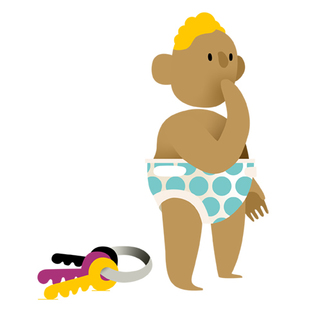
Alex Eben Meyer
Few of us have memories of being small children, never mind infants. But the precise reason why has remained elusive. Generally, scientists have theorized that this “blind spot” exists for one of two reasons: Either infants forget these memories later, or their brains weren’t developed enough to initially store them at all.
But a new study of memory in infancy—and the first study of infant memory to use functional MRI scans of infants’ brains—has provided a crucial, and groundbreaking, clue.
In the study, 26 infants were shown an image of a scene, face, or object they’d never seen before. A few images later, they were shown the same one again.
Because babies usually spend more time looking at objects that are familiar, if the infant looked at the image longer the second time, that would indicate that they remembered it. But how? “What we wanted to understand is what’s going on in their brain when they’re forming a memory,” says Yale psychology professor Nick Turk-Browne ’09PhD, the study’s senior author.
For that, the researchers needed to look at the hippocampus, the part of the brain that plays a critical role in memory formation. While numerous studies on memory in adults and older children have used functional MRI, none had been done on babies.
“It’s not a safety issue. It’s not that we needed different kinds of equipment,” Turk-Browne says. “It’s just that babies are the worst possible subjects for a functional MRI experiment.”
One challenge is that movement blurs the resulting image. Another is that, ideally, an MRI scan lasts an hour or two. To get around this, the team used techniques like putting the babies in pillows that stabilized their bodies, keeping the experiments to ten minutes, and making sure images were as interesting as possible. “We just do whatever is necessary to keep the babies happy,” Turk-Browne says.
The researchers found that, when babies were shown images the second time, the images they looked at the longest were those that had triggered the most activity in their hippocampus when they first saw them. In other words, the more active the baby’s hippocampus during an experience, the more likely the infant was to remember the experience later.
“This is what you see in adults and older children—and it wasn’t a given that we would see this in infants,” Turk-Browne says. “This brain region doubles in size during infancy. It’s changing, anatomically, massively. But even despite those anatomical changes, it already has this core functionality.”
And this starts early: The team found that the relationship between hippocampus activity and looking longer at images was strongest for babies aged one year and up.
Even that is earlier than the team had expected. It means that, while most people’s first memories are around ages four to seven, the hippocampus is able to start storing experiences several years earlier.
While these findings help answer whether babies can store memories, they’ve led to a new mystery: Where do those memories go? This is the focus of Turk-Browne’s research now.
“Now we have a window into this brain region that’s critical for memory formation that nobody’s had before,” Turk-Browne says. “That opens up many, many questions.”
 loading
loading